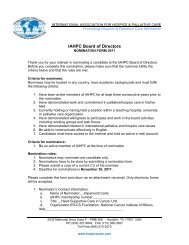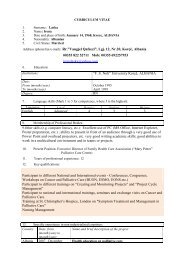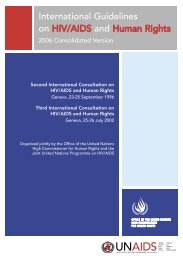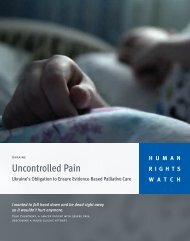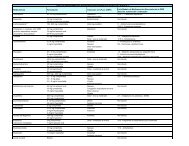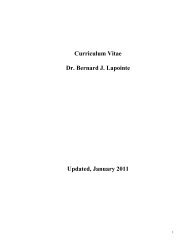INTERIGHTS Bulletin
INTERIGHTS Bulletin
INTERIGHTS Bulletin
Create successful ePaper yourself
Turn your PDF publications into a flip-book with our unique Google optimized e-Paper software.
<strong>INTERIGHTS</strong> <strong>Bulletin</strong><br />
Volume 16 Number 4 2011<br />
187<br />
protections are reiterated in RR v<br />
Poland and in both cases the European<br />
Court stated that retrospective<br />
measures alone are not sufficient, as<br />
by that point, the harm has already<br />
occurred. 25<br />
The cases in this article establish<br />
important protections and standards to<br />
ensure access to quality and respectful<br />
healthcare services in a timely manner.<br />
Elisa Slattery is Regional Director of<br />
the Africa Program at the Center for<br />
Reproductive Rights.<br />
1 For examples of reproductive rights violations in healthcare<br />
settings and how they can constitute torture, or<br />
cruel, inhuman or degrading treatment, see: Center for<br />
Reproductive Rights, Reproductive Rights Violations as<br />
Torture and Cruel, Inhuman, or Degrading Treatment or<br />
Punishment: A Critical Human Rights Analysis, 2011,<br />
available at .<br />
2 Ibid.<br />
3 For recent developments in litigating forced sterilisation,<br />
see P. Nair, ‘Litigating against the Forced<br />
Sterilization of HIV-Positive Women: Recent<br />
Developments in Chile and Namibia’, Harvard Human<br />
Rights Journal, vol. 23 (2010) available at<br />
. See also note 4.<br />
4 Preventable maternal deaths are also being litigated at<br />
the national level, in India and Uganda, for example.<br />
The work of the Human Rights Law Network in India<br />
can be found at: . For information on the litigation in<br />
Uganda, see A. Weseka, ‘Activists Storm Court Over<br />
Maternal Deaths’, The Monitor, 29 May 2011 at<br />
.<br />
5 Alyne da Silva Pimentel Teixeira v Brazil, CEDAW<br />
Committee, Communication No. 17/2008, Views<br />
adopted on 25 July 2011. The case was brought on behalf<br />
of Alyne’s family by the Center for Reproductive Rights<br />
and Advocacia Cidadã pelos Direitos Humanos.<br />
6 Ibid., para. 3.6.<br />
7 Ibid., para. 7.8.<br />
8 Ibid., para 7.5.<br />
9 See also: Committee on Economic, Social, and<br />
Cultural Rights, General Comment 14: The right to the<br />
highest attainable standard of health (22nd Session,<br />
2000); Ximenes Lopes v Brazil, 2006 Inter-Am. Ct.<br />
H.R. (ser. C) No. 149,para. 103 (4 July 2006) and A.S. v<br />
Hungary, CEDAW Committee, Communication No.<br />
4/2004, Views adopted on 14 August 2006, para. 11.5.<br />
10 For example of a large percentage of reproductive<br />
healthcare services being provided in private facilities,<br />
see, Center for Reproductive Rights & Federation of<br />
Women Lawyers-Kenya, Failure to Deliver: Violations of<br />
Women’s Human Rights in Kenyan Health Facilities,<br />
66 (2007), available at < http://reproductiverights.org/<br />
sites/crr.civicactions.net/files/documents/pub_bo_failu<br />
retodeliver.pdf>.<br />
11 Alyne, supra note 5, paras. 8.1-8.2.<br />
12 KL v Peru, Human Rights Committee,<br />
Communication No. 1153/2003, CCPR/C/85/D1153/<br />
2003, Views adopted on 24 October 2005.<br />
13 Ibid., para. 6.3.<br />
14 Ibid.<br />
15 RR v Poland (Appl. No. 27617/04, 26 May 2011). For<br />
further analysis of abortion-related cases against Poland,<br />
see Center for Reproductive Rights and Federation for<br />
Women and Family Planning, On the Case: R.R. v.<br />
Poland, S & T v. Poland, Z v. Poland and Tysiac v.<br />
Poland, available at .<br />
16 Ibid., para 206.<br />
17 Ibid., para. 151.<br />
18 Ibid., para. 159.<br />
19 Ibid., para. 160.<br />
20 KL v Peru, supra note 12, para. 5.2.<br />
21 Tysiac v Poland, (Appl. No. 5410/03, 20 March 2007).<br />
22 Ibid., para. 116.<br />
23 Ibid., para. 117.<br />
24 Ibid.<br />
25 Tysiac v Poland, supra note 21, paras. 124-127 and RR<br />
v Poland, supra note 15, para. 114.<br />
Endnotes continued from page 200<br />
25 See Amon et al, supra note 11, quoting Republic of<br />
South Africa, National Health Act, No. 61 of 2003<br />
(2004), s. 7; Republic of South Africa, Regulations<br />
Relating to Communicable Diseases and the<br />
Notification of Notifiable Medical Conditions,<br />
Government Notice No. R2438 (30 October 1987), available<br />
at ; and ‘South Africa: XDR-TB: Is<br />
forced isolation the cure’, IRIN News, 14 January 2009.<br />
See also AIDS Law Project, Human rights in the<br />
response to TB in South Africa: State and individual<br />
responsibilities, 2009.<br />
26 Supra note 11.<br />
27 Ibid. Nosocomial infection also known as a hospitalacquired<br />
infection is an infection whose development is<br />
favoured by a hospital environment.<br />
28 Even in developed world settings and with developed<br />
world facilities the Australian government notes that<br />
‘Again, prisons may not have the expertise or time to<br />
devote to management of this type of case. Also it is<br />
likely that even in prison the person may continue to be<br />
a risk, in this case to other inmates. Mechanisms may<br />
need to be explored to carry over case management into<br />
this setting.’ See New South Wales Government Policy<br />
Directive, supra note 18.<br />
29 Section 27 provides: ‘Where, in the opinion of the<br />
medical officer of health, any person has recently been<br />
exposed to the infection, and may be in the incubation<br />
stage, of any notifiable infectious disease and is not<br />
accommodated in such manner as adequately to guard<br />
against the spread of the disease, such person may, on a<br />
certificate signed by the medical officer of health, be<br />
removed, by order of a magistrate and at the cost of the<br />
local authority of the district where such person is<br />
found, to a place of isolation and there detained until, in<br />
the opinion of the medical officer of health, he is free<br />
from infection or able to be discharged without danger<br />
to the public health, or until the magistrate cancels the<br />
order.’<br />
30 See open letter by civil society organisations to the<br />
Government of Kenya at .<br />
31 An argument could also be made that the initial arrest<br />
and detention of the patients was unlawful under s 28 as<br />
an order for their isolation had not yet been made.<br />
However, this argument was not made and perhaps is<br />
not crucial considering the bigger issues in the case.<br />
32 Available at .<br />
33 A reading of the Act implies that it does not since isolation<br />
is defined as the ‘segregation and the separation<br />
from and interdiction of communication with others, of<br />
persons who are or are suspected of being infected.’<br />
This cannot be read to include detention in gaols unless<br />
special measures are put in place to provide TB wards in<br />
jails, which would seem a misdirection of resources<br />
when civilian hospitals do not have isolation wards.<br />
34 Section 17(1).<br />
35 Serious concerns with the effect and implementation<br />
of this section are beyond the scope of this article.<br />
36 KELIN’s pro bono Lawyer’s interview with client in<br />
Nanyuki SPM CR. No 856 OF 2011 Republic v James<br />
Kasena.<br />
37 The Kenyan Government uses ss 27 and 28 interchangeably<br />
and charges patients who fail to take their<br />
medicine with exposing the public to the danger of<br />
infection.<br />
38 There are three courts cases in the Kenyan High<br />
Courts of Eldoret, Embu and Meru that are seeking to<br />
challenge the arrest and detention of TB patients on the<br />
basis of provisions of the Public Health Act and the<br />
Penal Code. More information on these cases can be<br />
accessed from .



